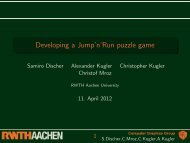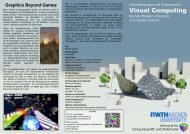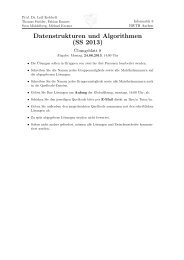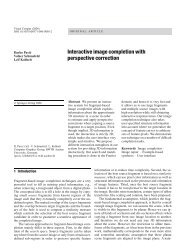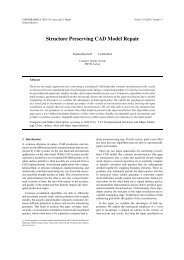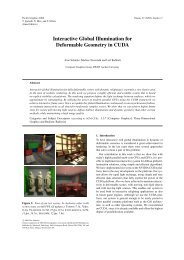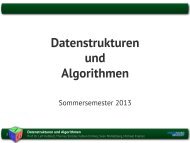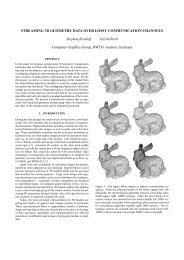sqrt(3) subdivision - Computer Graphics Group at RWTH Aachen
sqrt(3) subdivision - Computer Graphics Group at RWTH Aachen
sqrt(3) subdivision - Computer Graphics Group at RWTH Aachen
You also want an ePaper? Increase the reach of your titles
YUMPU automatically turns print PDFs into web optimized ePapers that Google loves.
Figure 7: Adaptive refinement ¢ based on 3-<strong>subdivision</strong> achieves<br />
an improved localiz<strong>at</strong>ion while autom<strong>at</strong>ically preventing degener<strong>at</strong>e<br />
triangles since all occuring triangles are a subset of the underlying<br />
hierarchy of uniformly refined meshes. Let us assume the horizontal<br />
coarse scale grid lines in the images have constant integer y<br />
coordin<strong>at</strong>es then the two images result from adaptively refining all<br />
triangles th<strong>at</strong> intersect a certain y const. line. In the left image<br />
y was chosen from1 2<br />
3 and in the right image y ε ¤ which<br />
explains the different localiz<strong>at</strong>ion.<br />
1¢ 3<br />
split(T)<br />
if (T.index is even) then<br />
compute midpoint P<br />
split T(A,B,C) into T[1](P,A,B),T[2](P,B,C),T[3](P,C,A)<br />
for i = 1,2,3 do<br />
T[i].index = T.index + 1<br />
if (T[i].m<strong>at</strong>e[1].index == T[i].index) then<br />
swap(T[i],T[i].m<strong>at</strong>e[1])<br />
else<br />
if (T.m<strong>at</strong>e[1].index == T.index - 2)<br />
split(T.m<strong>at</strong>e[1])<br />
split(T.m<strong>at</strong>e[1]) /* ... triggers edge swap */<br />
which autom<strong>at</strong>ically preserves the mesh consistency and implicitly<br />
maintains some mild balancing condition for the refinement levels<br />
of adjacent triangles. Notice th<strong>at</strong> the ordering of the vertices<br />
in the 1-to-3 split is chosen such th<strong>at</strong> reference m<strong>at</strong>e[1] always<br />
points to the correct neighboring triangle (outside the parent triangle<br />
T). The edge flipping procedure is implemented as<br />
swap(T1,T2)<br />
change T1(A,B,C), T2(B,A,D) into T1(C,A,D), T2(D,B,C)<br />
T1.index++<br />
T2.index++<br />
All the triangles th<strong>at</strong> are gener<strong>at</strong>ed during the adaptive ¢ 3-<br />
refinement form a proper subset of the uniform refinement hierarchy.<br />
This implies th<strong>at</strong> the shape of the triangles does never degener<strong>at</strong>e.<br />
The worst triangles are those gener<strong>at</strong>ed by an 1-to-3 split.<br />
Edge flipping then mostly re-improves the shape. Fig. 7 shows two<br />
adaptively refined example meshes. Another approach to adaptive<br />
mesh refinement with built-in consistency is suggested in [VG00].<br />
When adaptive refinement is performed in the context of st<strong>at</strong>ionary<br />
<strong>subdivision</strong>, another difficulty arises from the fact th<strong>at</strong> for the<br />
applic<strong>at</strong>ion of the smoothing rules a certain neighborhood of vertices<br />
from the same refinement level has to be present. This puts<br />
some additional constraints on the mesh balance. In [ZSS97] this is<br />
explained for Loop <strong>subdivision</strong> with dyadic refinement.<br />
For ¢ 3-<strong>subdivision</strong> it is sufficient to slightly modify the recursive<br />
splitting procedure such th<strong>at</strong> before splitting an even-indexed<br />
triangle by vertex insertion, all older odd-indexed neighbors have<br />
to be split (even-indexed neighbors remain untouched). This guarantees<br />
th<strong>at</strong> enough inform<strong>at</strong>ion is available for l<strong>at</strong>er applic<strong>at</strong>ions of<br />
the smoothing rule (2). The rule (1) is always applicable since it<br />
only uses the three vertices of the current triangle. Notice th<strong>at</strong> the<br />
1-to-3 split is the only way new vertices enter the mesh. Moreover,<br />
every new vertex eventually has valence six — although some of its<br />
neighbors might not yet be present.<br />
The modific<strong>at</strong>ion of the recursive procedure implies th<strong>at</strong> when a<br />
new vertex p is inserted, its neighboring vertices p 1 ¤¨§¨§¨§©¤ p 6 either<br />
exist already, or <strong>at</strong> least the triangles exist <strong>at</strong> whose centers these<br />
vertices are going to be inserted. In any case it is straightforward to<br />
compute the average 1 n ∑ i p i which is all we need for the applic<strong>at</strong>ion<br />
of (2).<br />
The remaining technical problem is th<strong>at</strong> in an adaptively refined<br />
mesh, the geometric loc<strong>at</strong>ion of a mesh vertex is not always welldefined.<br />
Ambiguities occur if triangles from different refinement<br />
levels share a common vertex since the smoothing rule (2) is noninterpol<strong>at</strong>ory.<br />
We solved this problem by implementing a multistep<br />
smoothing rule which enables direct access to the vertex positions<br />
<strong>at</strong> any refinement level. Accessing a Vertex-object by<br />
Vertex::pos(k) returns the vertex coordin<strong>at</strong>es corresponding<br />
to the kth refinement level. Vertex::pos(inf) returns the corresponding<br />
point on the limit surface which is the loc<strong>at</strong>ion th<strong>at</strong> is<br />
eventually used for display.<br />
Multi-step rules are generaliz<strong>at</strong>ions of the rule (2) which allow<br />
direct evalu<strong>at</strong>ion of arbitrary powers of S. As we already discussed<br />
in Section 3, the 1-ring neighborhoodp¤ p 0 ¤¨§¨§©§¨¤ p n¥1of a vertex<br />
p is mapped to (a scaled version of) itself under applic<strong>at</strong>ion of the<br />
<strong>subdivision</strong> scheme. This is reflected by the m<strong>at</strong>rix S in (3). If we<br />
compute the mth power of the <strong>subdivision</strong> m<strong>at</strong>rix in (3), we find in<br />
the first row a linear combin<strong>at</strong>ion ofp¤ p 0 ¤¨§¨§¨§¨¤ p n¥1which directly<br />
yields S m £ p¥ . For symmetry reason this multi-step rule can, again,<br />
be written as a linear combin<strong>at</strong>ion of the original vertex p and the<br />
average of its neighbors 1 n ∑ i p i .<br />
By eigenanalysis of the m<strong>at</strong>rix S it is fairly straightforward to<br />
derive a closed form solution for the multi-step rule [Sta98]:<br />
with<br />
especially<br />
S m p¥ : £ £ β<br />
β n<br />
1¦<br />
m¥ 3α<br />
£ n¦<br />
n £ m¥¨¥ p¢ β<br />
3α<br />
2 n α £ 3¦<br />
3α<br />
3α n<br />
1¢<br />
n<br />
1 n¥1<br />
n<br />
m¥ £<br />
n<br />
n ¥<br />
m<br />
∑<br />
i§0<br />
p i (7)<br />
β n §<br />
∞¥ £<br />
n<br />
Since the point p S ∞ p¥ on the limit surface is particularly important,<br />
we rewrite (7) by elimin<strong>at</strong>ing the average of p’s neighbors<br />
£ ∞¡<br />
with<br />
3α<br />
S<br />
1¢ m : γ £ p¥ n £ £ γ m¥ 1¦ p¢<br />
γ n £ m¥ <br />
¡2<br />
3¦ α<br />
n£m<br />
n £ m¥©¥ p ∞¡ (8)<br />
§<br />
In our implement<strong>at</strong>ion, every Vertex-object stores its original position<br />
p (<strong>at</strong> the time it was inserted into the mesh) and its limit<br />
position p ∞¡ . The vertex position <strong>at</strong> arbitrary levels can then be<br />
computed by (8).<br />
5 Boundaries<br />
In practical and industrial applic<strong>at</strong>ions it is usually necessary to be<br />
able to process control meshes with well-defined boundary polygons<br />
which should result in surfaces with smooth boundary curves.<br />
As the neighborhood of boundary vertices is not complete, we have<br />
to figure out special refinement and smoothing rules.<br />
When topologically refining a given open control mesh M 0 by<br />
the ¢ 3-oper<strong>at</strong>or we split all triangular faces 1-to-3 but flip only the



